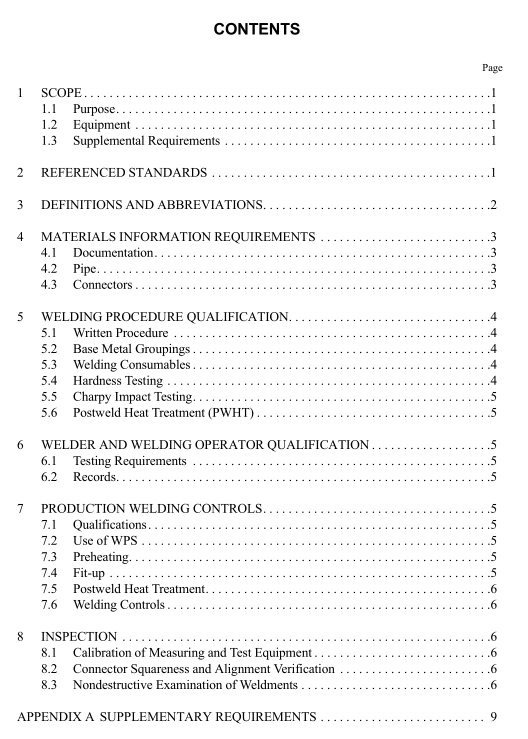API RP 5C6 pdf download

API RP 5C6 pdf download Welding Connections to Pipe
3Definitions and Abbreviations
3.1alignment: Refer to Section 8 of this document.3.2APl: Amcrican Petroleum Institute.
3.3ASME: American Society for Mechanical Engineers.3.4ASTM: American Society for Testing and Materials.3.5AWS: American wWelding Socicty.
3.6 axial alignment: Alignment to within specified tolerances of the connector centerline, to the centerline of the connector atthe opposite end of the pipe.
3.7base metal: Metal to be welded or cut
3.8 base metal grouping: System used to describe comparable base metal characteristics such as chemical composition,weldability, thermal processing,and mechanical properties.
3.9calibration: Comparison and adjustment of instruments to a standard of known accuracy.
3.10 carbon equivalent: Equation where variables are defined by base metal composition. The result is used as informationto help assess the base mctal weldability.
3.11 casing: Steel pipe used in oil wells to scal off fluids from the bore and to prevent the walls of the hole from sloughing offor caving.
3.12connector:Forging, machined to a geometry to function as a mechanical connection welded to pipe or casing.Othermaterials may be used if approved by purchaser.
3.13 connector parallelism: A measure of the connector face or plane with respect to the connector face at the opposite endof the pipe.
3.14cvN impact test: Charpy V-notch impact testing in accordance with ASTM A370.
3.15 discontinuity: An interruption of the typical structure of a weldment such as lack of homogeneity in the mechanical,metallurgical, or physical characteristics. A discontinuity is not necessarily a defect.
3.16 drift mandrel: A precision dimensioned cylinder sized to pass through or be inserted into the ends of pipe. lIt is passedthrough or into the pipe end lD to locate obstructions or to assure compliance with approprisate specifications,Other drift config-urations shall be approved by purchascr.
3.17fabricator: The company responsible for welding.
3.18grinding: Removing matcrial from a pipe surface or weld by abrading, c-.g.,grinding wheel.
3.19 hardness test: A measure of the hardness of a metal, as determined by pressing a hard steel ball or diamond penetrantinto a smooth surface under standard conditions.Results are often expressed in terms of Rockwell hardness number (HRB orHRC) or Brinell Hardness Number(BHN).Refer to the latest editions of ASTM E10 and ASTME18 for added information.3.20 heat affected zone(HAZ): Base metal zone adjacent to a weld that has had a metallurgical change induced by welding.3.21manufacturer:The company that manufactures the connector.
3.22 magnetic particle examination: A nondestructive test method utilizing magnetic flux leakage fields and suitable indi-cating materials to disclose surface and near-surface discontinuity indications.
3.23 NACE: National Association of Corrosion Engineers, previously NACE,now NACE International, Inc.
3.24 nondestructive exam (NDE):Imnspection to detect internal, surface, and concealed defects or flaws in materials usingtechniques that do not damage or destroy the items being tested.
3.25pipe: In this documcnt refers to plain end pipe to which connectors are to be welded.
3.26 postweld heat treat(PWHT):Thermal heat treatment applied at the completion of a weld as specified on the weldingprocedure specification.
3.27radiographic examination: The use of x-rays or nuclear radiation, or both, to detect discontinuities in material and topresent their images on a recording medium.
3.28 squareness: A measurement of the connector with respect to the pipe axis adjacent to the pipe end.
3.29weld: A localized coalescence of metals produced either by heating the materials to the welding temperature, with orwithout the application of pressure and with or without the use of filler metal.
3.30 weld reinforcement: Weld metal in excess of the quantity required to fill a joint sometimes referred to as the weld capon the O.D. and weld protrusion on the 1.D.
3.31 welded attachments: Attachments are equipment such as lift wyes and handling pads described on the purchase orderto supplement standard design of connector to pipe.
3.32welding consumables: Materials added to the coalescence of base metal (weld) that directly affect the weld metal’sproperties.
3.33welding procedure qualification record(PQR): A record of the welding data used to weld a test coupon.The PQRis a record of variables recorded during the welding of the test coupons.
3.34welding procedure specification (WPS): A writen qualified welding procedure prepared to provide direction formaking production welds.
3.35 visual examination: The primary evaluation of the fabrication weld joint. Visual aids and gauges are sometimes used.Inspection of welds usually includes quantitative as well as quality assessment of the joint.
3.36 welder performance qualification (WPQ): The qualification of a welder or welding operator. The qualificationrequires the welder or welding operator to weld a test coupon in accordance with the WPS. The test coupon is then tested inaccordance with the applicable welding code.The qualification limitations are provided in the requirements of the applicablewelding code.
4Materials lnformation Requirements4.1 DOCUMENTATION
When materials (pipe or connectors) are furnished by the purchaser, they should be accompanied by traceable material test reportsor data sheets stating chemical analysis, heat treatment condition and mechanical properties to allow for selection of welding pro-cedure specifications by the fabricator.









